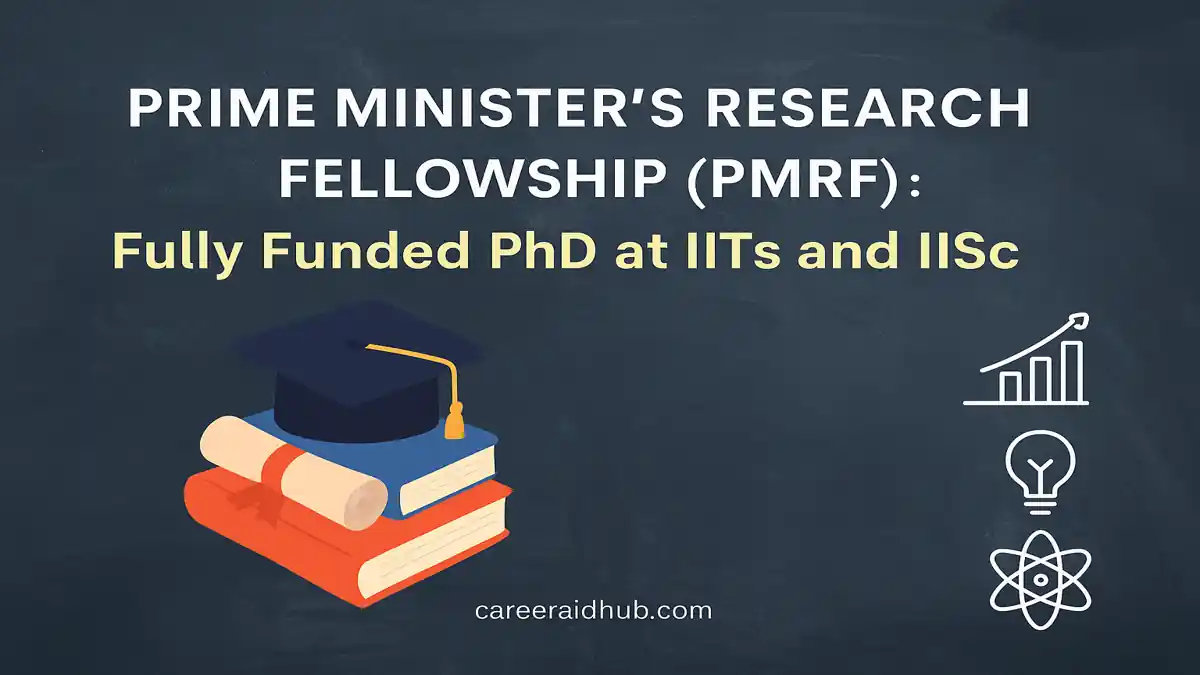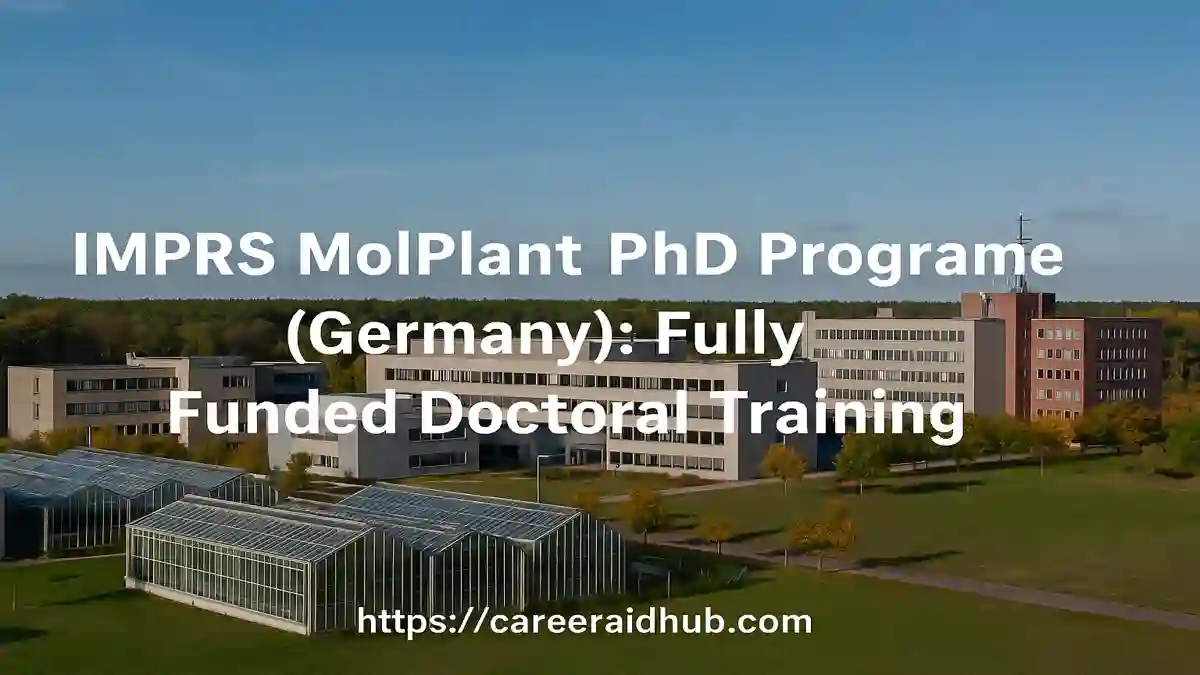Prime Minister’s Research Fellowship (PMRF): Your Gateway to a Fully Funded PhD at IITs and IISc
Introduction
The Prime Minister’s Research Fellowship (PMRF) is an ambitious initiative launched by the Ministry of Education, Government of India, to nurture India’s research ecosystem by retaining top talent within the country. Aimed at fostering excellence in science, technology, and engineering research, PMRF provides one of the most generous and competitive PhD funding opportunities in India. It is open to outstanding candidates from institutes such as IITs, IISc, IISERs, NITs, and other centrally funded technical institutions.
PMRF not only offers a robust financial package but also emphasizes mentorship, interdisciplinary research, and societal impact. Whether you are transitioning directly from a B.Tech/M.Tech/M.Sc or already enrolled in a PhD program, PMRF offers structured entry routes to help you pursue doctoral studies at elite Indian institutions.
The Prime Minister’s Research Fellowship (PMRF) offers exceptional graduate students the chance to pursue fully funded PhD programs at India’s leading institutes, including IITs and IISc. With stipends up to ₹80,000 per month and an annual contingency grant, PMRF supports high-impact research in science, technology, and innovation.
What is the Prime Minister’s Research Fellowship (PMRF)?
The PMRF is a government-funded fellowship designed to attract highly qualified candidates into research programs across India’s premier institutes. The fellowship aims to create a pool of talented researchers who can drive innovation, support India’s self-reliance agenda, and contribute to global scientific advancement.
Selected candidates are offered financial support, academic mentorship, and exposure to cutting-edge infrastructure and labs. The fellowship is distinguished by its high monthly stipend and annual contingency grants that support equipment, travel, and research publication costs.
Fellowship Benefits at a Glance
One of the standout features of PMRF is its comprehensive financial support:
| Academic Year | Monthly Stipend (₹) | Annual Contingency Grant (₹) |
|---|---|---|
| Year 1 | 70,000 | 2,00,000 |
| Year 2 | 70,000 | 2,00,000 |
| Year 3 | 75,000 | 2,00,000 |
| Year 4 | 80,000 | 2,00,000 |
| Year 5 | 80,000 | 2,00,000 |
Additional Highlights:
-
-
No service bond required after completion.
-
Funding covers tuition, research, and development expenses.
-
Encourages publications in high-impact international journals.
-
Host Institutes
PMRF is available at India’s most reputed research institutes. These host institutes play a critical role in the selection, mentoring, and evaluation of PMRF fellows. They are categorized as
Participating Institutions:
-
-
Indian Institutes of Technology (IITs)
-
Indian Institute of Science (IISc), Bangalore
-
Indian Institutes of Science Education and Research (IISERs)
-
National Institutes of Technology (NITs)
-
These institutes offer advanced laboratories, interdisciplinary departments, and internationally trained faculty who provide expert mentorship throughout the doctoral journey.
Eligibility Criteria
PMRF offers two distinct modes of entry to accommodate different academic backgrounds:
1. Direct Entry Track
Designed for recent graduates from India’s top institutions who are entering PhD programs directly after B.Tech, BE, Integrated M.Tech, or M.Sc:
-
-
Must have completed or be in the final year of the above degrees from IISc, IITs, NITs, IISERs, or centrally funded technical institutes.
-
Must secure admission in a PhD program at a PMRF-granting institute.
-
Minimum CGPA requirement is 8.0 on a 10-point scale.
-
A research proposal and excellent academic credentials are mandatory.
-
2. Lateral Entry Track
This track is for candidates who are already enrolled in a PhD program at a PMRF-participating institute:
-
-
Must have completed less than 12 months in the PhD program.
-
Must
demonstrate strong research output (e.g., publications, projects). -
Requires an endorsement from the host institution and submission of a well-structured research proposal.
-
PMRF Application Timeline (Tentative)
The fellowship operates on two application cycles each year—May and December. While the exact dates may vary annually, the following timeline provides a general overview:
| Stage | May Cycle | December Cycle |
|---|---|---|
| Notification Release | March | August |
| Application Window | March to April | August to September |
| Institute Shortlisting | May | October |
| Final Selection Results | June | November |
| Fellowship Start Date | July | December |
Next Cycle Update: Expected in August 2025 for the December cycle. Exact dates will be published on the PMRF official site. We will update this section accordingly.
Application Process
Applying for PMRF involves a two-step process. Candidates must follow institutional and national guidelines for successful consideration.
Step 1: Admission to a PhD Program
The first requirement is to secure admission in a PhD program at any of the PMRF-participating institutes. Without confirmed admission, a candidate cannot apply for PMRF.
Step 2: Submission of PMRF Application
Once admitted, the applicant must submit the
-
-
Academic transcripts
-
Statement of Purpose (SoP)
-
Research proposal
-
Letters of Recommendation (for Direct Entry)
-
Institutional endorsement (for Lateral Entry)
-
Applications are reviewed by national panels composed of subject-matter experts and institute representatives.
What Makes a Strong Application?
Due to its competitive nature, a successful PMRF application should reflect high academic and research potential. Key components include:
-
-
Consistent academic performance with a CGPA ≥ 8.0.
-
Well-structured research proposal that aligns with national development goals or frontier research domains.
-
Evidence of research aptitude through internships, research projects, or published papers.
-
Strong recommendation letters that highlight the applicant’s motivation, research skills, and academic integrity.
-
For Lateral Entry applicants, performance in the first year of PhD (publications, seminars, internal reviews) carries significant weight.
-
Why Choose PMRF?
PMRF is designed not just as a funding mechanism but as a holistic research empowerment platform. Here’s why it stands out:
-
-
Generous financial support unmatched by most domestic fellowships.
-
Opportunity to work under top-tier faculty and mentors.
-
Access to state-of-the-art laboratories and interdisciplinary research networks.
-
Encouragement for international publications, patents, and conference presentations.
-
No service bond, allowing career flexibility post-PhD.
-
Opens doors to global postdoctoral opportunities and policy leadership roles.
-
Recent Trends and Focus Areas
PMRF has been increasingly aligned with national research priorities and global scientific challenges. The following trends are shaping current selections:
-
-
Focus on applied and translational research that contributes to nation-building.
-
Emphasis on interdisciplinary themes like Artificial Intelligence, Climate Change, Renewable Energy, Quantum Computing, and Public Health.
-
Increased inclusivity, with efforts to encourage participation from women, differently-abled, and underrepresented communities.
-
Higher weightage on candidates with problem-solving experience, innovation exposure, or startup collaboration.
-
Who Should Apply?
You should strongly consider applying for PMRF if you meet the following criteria:
-
-
You are a high-performing student from a centrally funded technical institute.
-
You aspire to become a researcher, academician, or scientist.
-
You are interested in solving critical national or global challenges through research.
-
You seek a flexible, well-funded PhD opportunity in India’s top institutions.
-
Conclusion
The Prime Minister’s Research Fellowship represents a transformative opportunity for India’s brightest minds to immerse themselves in high-quality, nationally relevant research. With its generous funding, supportive academic structure, and global recognition, PMRF offers the ideal platform for aspiring researchers to realize their potential and make lasting contributions to science and society.
If you aim to be part of India’s scientific renaissance, start preparing your profile, focus on crafting a compelling research proposal, and stay updated on the next PMRF cycle at www.pmrf.in.
| Feature | Details |
|---|---|
| Program Name | Prime Minister’s Research Fellowship (PMRF) |
| Host Country | India |
| Funded By | Ministry of Education, Government of India |
| Duration | Up to 5 years |
| Study Mode | Full-time |
| Eligibility | Graduates from centrally funded institutes; PhD admission at a PMRF institute |
| Financial Support | ₹70,000–80,000/month stipend + ₹2 lakh/year contingency grant |
| Fields of Study | Science, Engineering, Technology, and Interdisciplinary Research |
| Deadline | Next cycle: Expected August (Exact dates will be updated soon) |
| Official Website | Click Here |
References
-
PMRF Official Portal – https://www.pmrf.in
-
Ministry of Education, Government of India – https://www.education.gov.in
FAQs
PMRF scholars receive ₹70,000 to ₹80,000 per month, along with an annual contingency grant of ₹2 lakh for research-related expenses.
Candidates with a CGPA of 8.0 or above from top institutions and direct admission into a PhD program at a PMRF institute are eligible.
Yes, B.Tech or Integrated M.Tech graduates from premier institutes can apply through the Direct Entry track if they meet eligibility criteria.
The PMRF supports PhD students for a maximum of five years, subject to annual performance evaluations.
Yes, recommendation letters are mandatory for the Direct Entry track to assess academic and research potential.
PMRF has two cycles: May and December. Applications typically open in March and August respectively. Exact dates are announced on the official portal.
Yes, students already enrolled in a PhD program for less than 12 months can apply through the Lateral Entry track.
No, PMRF does not require a service bond or post-PhD obligation, allowing full career flexibility.
PMRF is available at IITs, IISc, NITs, IISERs, and other centrally funded research institutes across India.
The PMRF selection process is highly competitive, focusing on academic excellence, research potential, and alignment with national research priorities.
Premium Mentorship for a Stronger Application
- Premium Mentorship: personalised 1:1 guidance for this and similar opportunities
- In-depth review of your CV, academic profile, and key statements
- Aligned with international selection criteria so your profile matches what panels expect
- Stronger, more compelling narrative for highly competitive calls
- Step-by-step support from opportunity mapping to final submission (fee-based)










